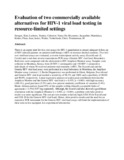| dc.description.abstract | There is an urgent need for low-cost assays for HIV-1 quantitation to ensure adequate follow-up of HIV-infected patients on antiretroviral
therapy (ART) in resource-limited countries. Two low-cost viral load assays are evaluated, a reverse transcriptase activity assay (ExavirLoad v2,
Cavidi) and a real-time reverse transcriptase PCR assay (Generic HIV viral load, Biocentric). Both tests were compared with the ultrasensitive
HIV Amplicor Monitor assay. Samples were collected in Mombasa, Kenya, from 20 HIV-1 seronegative and 150 HIV-1 seropositive individuals
of whom 50 received antiretroviral treatment (ART). The ExavirLoad and the Generic HIV viral load assay were performed in a local laboratory
in Mombasa, the Amplicor Monitor assay (version 1.5, Roche Diagnostics) was performed in Ghent, Belgium.
ExavirLoad and Generic HIV viral load reached a sensitivity of 98.3% and 100% and a specificity of 80.0% and 90.0%, respectively. Linear
regression analyses revealed good correlations between the Amplicor Monitor and the Generic HIV viral load (r = 0.935, p < 0.001) with high
accuracy (100.1%), good precision (5.5%) and a low percent similarity coefficient of variation (5.4%). Bland–Altman analysis found 95% of
the samples within clinically acceptable limits of agreement (−1.19 to 0.87 log copies/ml). Although, the ExavirLoad also showed a good linear
correlation with the Amplicor Monitor (r = 0.901, p < 0.001), a problem with false positive results was more significant. The cost per test remains
relatively high (US$ 30 for ExavirLoad and US$ 20 for the Generic HIV viral load). Hence, false positive results and the need for an expensive
PCR instrument for the Generic HIV viral load assays still limit the implementation of these tests in less equipped, less experienced laboratories | en |

